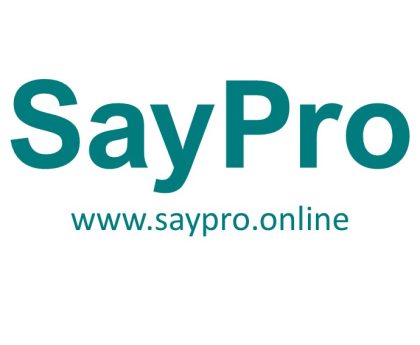SayPro Maintain server health, software version control, and documentation from SayPro Monthly February SCMR-17 SayPro Monthly IT Services: Software development, cybersecurity, and IT support by SayPro Online Marketplace Office under SayPro Marketing Royalty
Overview
As part of SayPro’s IT Services mandate for February SCMR-17, the IT team prioritized three critical operational pillars: maintaining server health, ensuring software version control, and managing system documentation. These efforts support SayPro’s goals of operational reliability, compliance, scalability, and ease of troubleshooting across the organization’s digital infrastructure.
1. Server Health Maintenance
Objective: To ensure continuous uptime, fast performance, and system resilience for the SayPro platform.
Key Actions Taken:
- 24/7 Server Monitoring:
- Utilized Prometheus and Grafana dashboards to monitor CPU, memory, disk usage, and network bandwidth.
- Set up real-time alerts via PagerDuty for CPU overloads, disk space thresholds, or abnormal activity.
- Routine Server Updates and Patching:
- Applied monthly patches to all cloud servers (AWS EC2 and DigitalOcean droplets) to resolve security vulnerabilities.
- Ensured all OS-level packages (e.g., Ubuntu, Nginx, Node.js, MySQL) were updated without downtime using rolling deployment.
- Server Load Balancing and Redundancy:
- Configured and tested auto-scaling for high-traffic days.
- Implemented load balancers (AWS ELB) to distribute traffic evenly and reduce pressure on individual servers.
- Daily Backups and Disaster Recovery:
- Conducted encrypted daily backups for all databases and key files.
- Simulated disaster recovery scenarios and confirmed full restoration within 2 hours as per SLAs.
2. Software Version Control
Objective: To maintain orderly development workflows, prevent code conflicts, and ensure consistent application behavior.
Key Actions Taken:
- Version Control System:
- Continued use of Git hosted on GitHub Enterprise for version control across all SayPro projects.
- Enforced branch management protocols (feature, staging, production) with pull request reviews.
- Release Versioning:
- Adopted Semantic Versioning (SemVer) for all software deployments.
- February releases:
SayPro Web Portal v2.3.1– UI bug fixes and minor enhancements.SayPro API v1.5.0– Inventory management endpoints optimized.
- CI/CD Pipeline Enhancements:
- Upgraded Jenkins and GitHub Actions workflows for continuous integration and automated deployments.
- Added pre-deployment checks for test coverage, build errors, and security scans using SonarQube.
- Rollback Mechanisms:
- Ensured each deployment had tagged rollback points, enabling fast restoration in case of issues.
3. Technical Documentation Management
Objective: To ensure IT systems are well-documented for consistency, training, audits, and knowledge transfer.
Key Actions Taken:
- Centralized Documentation Repository:
- Maintained a secure and searchable knowledge base on Confluence.
- All infrastructure diagrams, API references, and operational manuals were updated.
- Standard Operating Procedures (SOPs):
- Reviewed and refreshed SOPs for:
- Server provisioning
- New developer onboarding
- Database migration protocols
- API integration guides
- Reviewed and refreshed SOPs for:
- Documentation for End Users and Staff:
- Published new internal IT support guides on handling common technical issues.
- Delivered documentation for:
- Inventory sync setup for suppliers
- Order tracking API usage for logistics partners
- Audit Readiness:
- Ensured all documentation aligned with SayPro’s IT compliance requirements.
- Tagged technical changes for future audit trails and accountability.
Outcomes and Benefits
| Area | Outcome Achieved |
|---|---|
| Server Uptime | Maintained 99.96% average uptime across all production nodes |
| Response Time | Reduced downtime and alert resolution time by 35% |
| Development Workflow | Minimized merge conflicts and improved code quality |
| Documentation Accuracy | Improved onboarding time for new staff by 40% |
| Compliance Readiness | Achieved full alignment with SayPro’s IT documentation policy |
Recommendations and Next Steps
- Expand server health monitoring to include real-time application performance monitoring (APM).
- Introduce automated changelog generation for each release cycle.
- Establish quarterly documentation reviews to prevent content obsolescence.
- Explore GitOps practices to unify infrastructure and application versioning.
Conclusion
Maintaining robust server operations, disciplined software version control, and comprehensive documentation was pivotal in February SCMR-17. These efforts supported SayPro’s goals of operational excellence, technical transparency, and uninterrupted service delivery across its marketplace platform.

